QuestionQUESTION: Hi Jennifer, I have a 120 gallon freshwater tank and am looking to convert it to a saltwater fish only tank. I have a AquaClear 110 HOB power filter and the Rena XP4 canister filter. Would those filters be ok to use for my Saltwater Tank? I am going to buy a good protein skimmer (are coral life skimmers ok?). I have a few questions and I really appreciate your help :) First, I have the gravel as my substrate, I know live sand is preferred, but would the regular gravel do ok or should I replace it? I am close to the beach, would beach sand be ok to use as the substrate or does it have to be a special type? For cycling purposes, would you recommend getting some live rock? Because of the cost, I really don't want to add 120 pounds of the live rock. If you think I should add it. would you recommend adding say 25 pounds of rock to help out? I just had a really hard time getting the freshwater tank to cycle and that is my biggest concern with the saltwater tank. Does the Marineland Bio Spira work to help speed the cycle? My brother had a saltwater reef tank with live sand and live rock and corals. Do you think I would have any problems if I added some of his substrate to mine and some of his filter material to my filter? Thank you Jennifer very much for the help, Mike
ANSWER: Hi Mike. I am not all that familiar with the coralife skimmers but from what I have seen of them I am also not all that fond of them either. A much better choice would be a tunze DOC, Aqua-C remora pro or a red sea prism pro deluxe. But that is just a matter of my opinion and what I prefer.
You will have to replace your gravel with a substrate made for use in a saltwater tank. These coral sand substrates help to buffer the water and keep it at a stable PH. Using regular gravel may have a negative effect on your pH and there are some rocks that can actually make your tank uninhabitable for saltwater fish. You will not want to use sand from a beach either. As the waves wash up on shore they act as a giant protein skimmer depositing dissolved organic waste products from the ocean. The sand on a beach is filthy as far as saltwater tank standards go and you run the risk of pollutants showing up in your tank. Collecting sand off shore can be done but it must also be cured before it is put into your tank. This requires storing it in a dark container of saltwater, changing out the water every few days for a few weeks. This seems like a lot of trouble!
I do not recommend cycling a tank solely with live rock. A lot of the organisms that make up live rock are very intolerable of the high ammonia during the cycling process. In turn the organisms die off and can raise the ammonia to even higher levels thus jeopardizing the good bacteria as well. If the rock is fully cured then there is usually not enough living organisms on the rock to produce enough ammonia to fully cycle a tank and it can take several months for the population of these organism to populate the rock and to get a good cycle going. If you are planning to a fish only tank then live rock is not needed at all or you can add a smaller amount of live rock and combine that with some reef rock or lava rock and let the live rock simply seed your "dead" rock. Just be sure that any rock you will use is reef safe. One of my tanks has no live rock in it and this not something you must have to keep a saltwater tank! A much better choice is combine the use of live rock with a good maturation fluid or simply feed small amounts of frozen meaty marine foods to an empty tank coupled with a live bacterial culture( any brand live culture). Using some of the substrate, live rock, and filter material from an already established tank will speed up the cycling process tens times better than any other way of cycling! Charting the progress of your cycling is very important and the water should be tested at least every other day during this time for ammonia, nitrite and nitrate.
---------- FOLLOW-UP ----------
QUESTION: Hi Jennifer, thank you so much for your response, I appreciate it so much. You and the site provide such a wonderful service. I will definitely get one of your recommended protein skimmers.
Great on the sand, let me ask you this, I read an article online and the author said, to save on cost over LFS live sand, he recommended buying sand from Home Depot-"Look for Southdown Play Sand. It is a very good aragonite sand and has fine particle size. It will cost about $4 for 50lbs." Would this work Jennifer? How many pounds of sand would you recommend for a 120 gallon tank, I have the 5 foot long tank, that is taller than the 6 foot ones.
Jennifer, I'm going to do like your fish only tank and go without live rock for now. If I added live sand from an established tank and put used media from the established tank into my tank filter, shouldn't that really help the cycling process? So do you think if I added a product like Bio Spira, add an ammonia source such as raw shrimp, with the sand and used filter, would that be about all I would need to get the cycling going? Know it will take time for sure!
Thank you Jennifer for your great help, take care, Mike
AnswerGlad to help! I have heard of using this sand as a cheap alternative to the kind that you can purchase at a pet store and there are many people who use it with no long term problems. The one thing I will warn you about is that you MUST rinse it very well before adding it to your tank! The sand is extremely dusty and it can take over a week for your tank to clear up after set up if you do not rinse it well. It is always a good idea to rinse your sand or gravel before adding it to your tank(unless it is live sand of course) but this sand may take a few extra rinses over regular made for tank substrates. However because it is primarily made of aragonite it will buffer your pH and work well for a marine fish only tank. The particle size is great for sand sifting fish or delicate fish like sharks and rays who tend to be easily scratched by a more course sand. I've never personally used it(And I don't recommend it to my customers because that would not be good for business!) but I have read many good things about this inexpensive alternative.
Using filter media and live sand from an already established tank will greatly speed up the cycling process for your tank. Your idea for getting the cycling going will work,the only downfall is that you may need to continue to "feed" your tank for a few weeks during this process. Raw shrimp, like the kind you would buy at a grocery store may foul up your tank quickly and make you go through a harder cycle than you need to. I recommend using smaller meaty marine fish foods and simply add a little every other day. This process can be a bit tricky and you will need to monitor your tank's water quality often to ensure that you are feeding an adequate amount to create a healthy enough colony to support your fish down the road. One of the other draw backs to this method is that if your bacteria do not colonize in a large enough of a colony when you do eventually add fish you still may go through a slight recycling. Decaying food particles will provide your tank with ammonia but can also give off other undesirable by products such as phosphate. I usually suggest the use of black mollies for getting the cycling process going in a tank that will not contain live rock or live sand. The reason why black mollies work so well is that if acclimated very slowly to saltwater they will thrive in it. Not only that but they are very able to with stand the high levels of ammonia and nitrite that they encounter during the cycling process. They can be used for cycling and simply re-acclimated back to fresh or kept indefinitely in your saltwater tank. They are great at picking and eating all kinds of algae off of the walls and decorations in a saltwater tank.

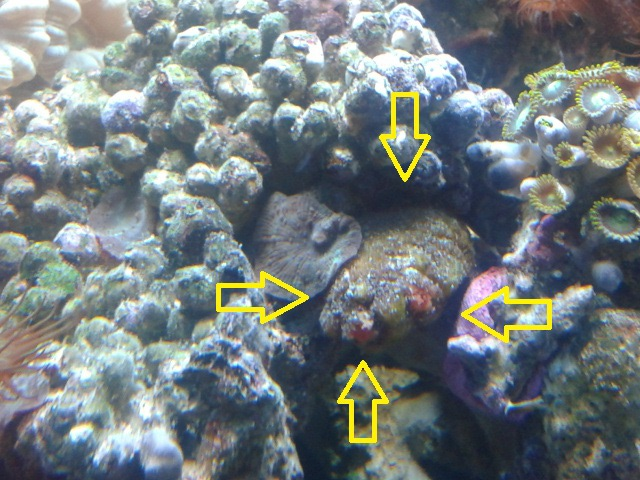 Unknown rock growth maybe?
Question
saltwater alien?
I have a rock with sev
Unknown rock growth maybe?
Question
saltwater alien?
I have a rock with sev
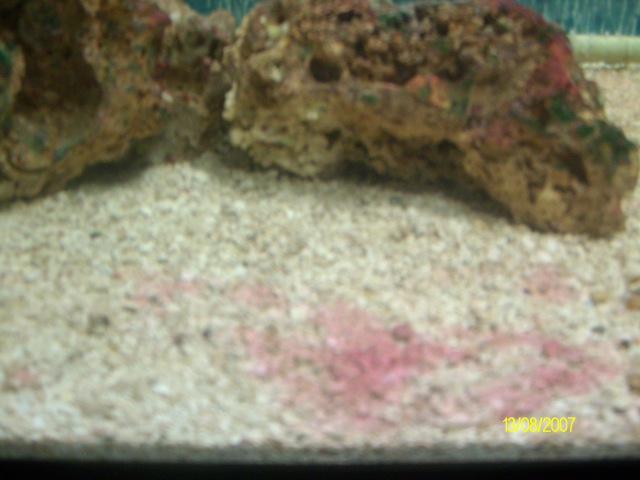 red green on live rock
Question
live rock
i was wondering if this green and re
red green on live rock
Question
live rock
i was wondering if this green and re
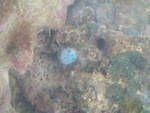 groth on live rock
Question
rock growth
Hello
can you please identify thi
groth on live rock
Question
rock growth
Hello
can you please identify thi
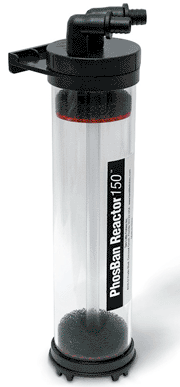 Red Slime
QuestionMy tank was cycled , beautiful, stocked, up & r
Red Slime
QuestionMy tank was cycled , beautiful, stocked, up & r
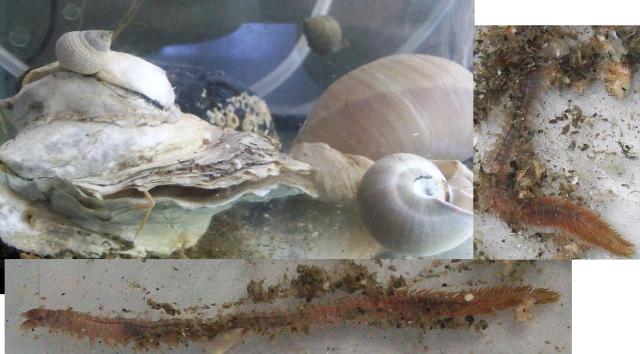 Bristle worms (I think)
Question
My tank
Memorial day weekend my family and I w
Bristle worms (I think)
Question
My tank
Memorial day weekend my family and I w